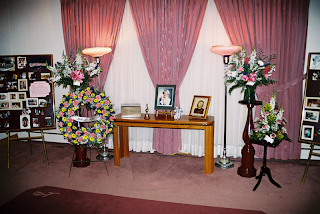 |
| My late mother's celebration of life |
Here are three aspects to the passing of a loved one: grief, bereavement, and mourning.
Grief never leaves you, it is a sign that someone was loved and will be missed and it is a normal part of loss.
In bereavement, it is a state of loss of someone or something. Many cultures and religions have specific mourning rituals. Mourning is the outward expression of this loss.
In some, grief is transferred into anger, rather than celebration of a life, or choosing to make a difference, such as those who lobby for organ donations, Mothers Against Drunk Drivers (MADD), or *
Threads of Life
.
Many lash out in anger, directed at those responsible or not. You can watch such people, whom the media love to capture on video, as they deal with their grief. Displaced anger isn't pretty. Screaming people, lashing out at those who are not responsible. Or things, like cancer, when cells go awry. In an untimely death, it breaks my heart to see outward expressions of the anger. You know they need help in dealing with the loss.
*Threads of Life is a national registered Canadian charity dedicated to supporting families along their journey of healing who have suffered from a workplace fatality, life-altering illness or occupational disease. We help these families protect future generations of Canadian workers.
Grief is carried with us like a sack of stones. When we walk along the road, on our journey, we bring out the stones, examine them, and each time we lose something, or some one, we add a stone.
 |
| A child and her mentor work the clay while they work out their grief |
There is so much work to grief. I have learned to honour the memories, not to fear the death.
The work of grief is endless. It is a part of the life of the living. Each time we grieve, we pick up more stones to put in our sack. Whether it is the death of a grandparent, pet, a career, loved one, loss of a home, or a life when family splits up. We can let the sack slow us down, dragging it in the dirt behind us, or we can chose to lighten our burden.
Hospices provide bereavement groups. Many provide Art Therapy groups for children, as well. I participated in one. It is truly loving to share your grief with another. Support groups provide much in the way of hope. Not ridiculous hope. But hope for the small things. To laugh at least once a day. When we share our grief and examine one another's stones, we realize that grief shared, is grief that become a diamond.
 In our bereavement groups we shared our stories. We brought out the stones from our sacks, held them up to the light of day. The stones can change in the sharing, to become precious jewels when they see the light of day.
In our bereavement groups we shared our stories. We brought out the stones from our sacks, held them up to the light of day. The stones can change in the sharing, to become precious jewels when they see the light of day.I read a mystery novel, Summer Time, by Liz Rigbey, and she wrote:
"We all need to tell stories. Stories frame events. Once we massage life's traumas into a narrative form they become less destructive."We gave language to our thoughts and feelings. Kübler-Ross had it right: anger, denial, bargaining, depression, acceptance. None of these feelings are wrong. They just are, and by sharing them, these stones that weigh us down, we turn the stones into precious jewels. Like the earth that compacts coal into diamonds, those around us convert our stones into things of beauty. For if you have never loved something, there would be no pain in the loss. If you have never lost something, you would never know the joy, and the sorrow.
1 comment:
With all the excellent information on grief and grieving I am always puzzled at how few people inform themselves about this stage of life.
You've done your homework on the topic.
Thanks for dealing with a heavy topic.
Post a Comment